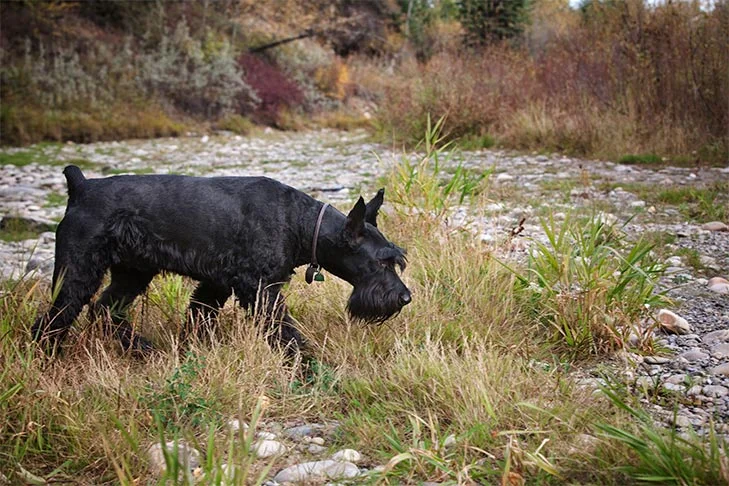The Giant Schnauzer is a bigger, stronger version of the Standard Schnauzer, and according to the breed standard, he should “be a bold and valiant figure of a dog.” His superior intelligence and loyalty make him a fantastic worker and friend. The Standard Schnauzer and the well-bred Giant Schnauzer are very similar dogs. Giants are powerful, as their name implies. Males can weigh 95 pounds and stand as tall as 27.5 inches at the shoulder. The Mini, Standard, and Giant are known for their sharp beard and eyebrows, emphasizing a keen, sagacious look. The muscular, robust body is, in the words of the breed’s fanciers, a “bold and valiant figure of a dog.” The double coat is either pure black or “pepper and salt.”
Giant Schnauzer
Average sizes and life
expectancy of the breed.
Height
25.5-27.5 inches (male)
23.5-25.5 inches (female)
Weight
60-85 pounds (male)
55-75 pounds (female)
Life Expectancy
12-15 years
Breed Traits & Characteristics
About the Breed

Owning a dog is not just a privilege; it’s a responsibility. They depend on us for, at minimum, food and shelter, and deserve much more. When you take a dog into your life, you need to understand the commitment that dog ownership entails.
 Health
Health
Recommended Health Tests From the National Breed Club:
- Hip Evaluation
- Thyroid Evaluation
- Ophthalmologist Evaluation
 Grooming
Grooming
 Exercise
Exercise
 Training
Training
Extremely intelligent and strongly territorial, the Giant Schnauzer loves his owners and feels great responsibility to protect them. He learns quickly and can distinguish between friend and foe. Giants want to be with their owners and cannot abide being ignored or left in the yard. A Giant Schnauzer needs to have a job'¿even something as simple as chasing a ball. The Giant is a 'high-energy, protective, territorial guard dog,' says one prominent breed fancier. 'The breed is not for the casual owner.' Giants do best with fenced-in running room, regular exercise, and activities that provide mental and physical exercise. They enjoy and excel in dog sports such as carting, herding, agility, coursing ability tests, and obedience. Early socialization and puppy training classes are a must with this strong, protective breed.
 Nutrition
Nutrition
History
Sometime in the middle of the 1800s, the Giant Schnauzer was produced in the Bavarian Alps. These hardy labor dogs, developed from the Standard Schnauzer, were employed to herd livestock from the ranch to the market.
They were also effective guard dogs for farmers, businesspeople, and innkeepers. Cattle drives were rendered useless by railroads, thus Giants found employment as K-9s for the military and police in Europe. Giants were well-known in America as attractive show dogs, outstanding obedience competitors, and brave protectors of the home and family.


